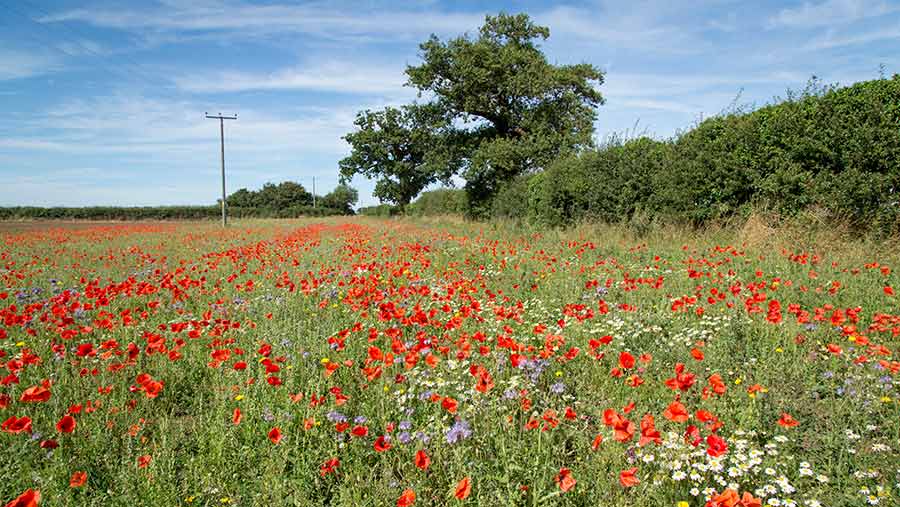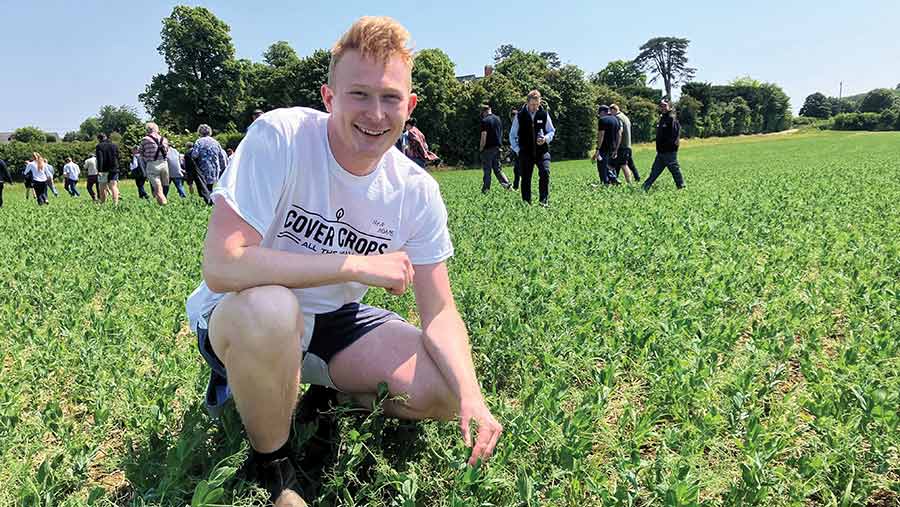SFI 2023: What’s on offer for arable farmers
 © GNP
© GNP The full version of the Sustainable Farming Incentive 2023 for England was revealed in June, receiving a mixed reception from growers and advisers alike.
With 23 actions and a far more flexible feel, at first glance it offers much of what the farming industry has been calling for, with its “pick and mix” approach.
A more detailed inspection shows there are many similarities with Mid Tier Countryside Stewardship (CS), with repackaged existing options being a sizeable proportion of the “new” actions.
See also: Tips on establishing perennial wildflower strips for bees
While payments rates across common Sustainable Farming Incentive (SFI) and CS options largely mirror each other, there are some differences that growers need to be aware of before committing to either scheme (see “Main differences: SFI v Mid Tier CS”).
Wide uptake
The aim with such a broad offer is that growers can do as much or as little as they want from a selection of in-and-around-the-field actions, says Janet Hughes of Defra, who confirms that further actions will be added next year.
“It’s been designed for mass uptake and targets the sweet spot of being good for both the farm and the environment.”
SFI 2023 replaces the 2022 version, where actions were grouped in packages as standards and different ambition levels could be achieved.
The most popular were the introductory and intermediate soils standards, which paid £22/ha and £40/ha, respectively.
These standards are now closed and will not be used in future; instead, a controlled rollout of SFI 2023 will take place from August.
While they will be compensated for their initial efforts, early adopters have been left disheartened. Having planned rotations, drawn up budgets and committed to increase their level of ambition over time, they are back to square one.
Trust and confidence
“The removal of key elements from the 2022 scheme is disappointing, especially the progressive whole farm approach previously outlined,” says Joe Spencer, partner at accountants MHA.
“It looks as though we now have a diluted version – many of the actions unveiled were already available in Countryside Stewardship.”
Changing a scheme so rapidly and with no warning doesn’t give farmers confidence in Defra’s strategy or vision for the industry, he notes.
Ian Gould, co-owner of Oakbank, stresses that it’s early days and that many are still getting their heads round the 2023 offer.
There are new actions that will appeal to arable farmers, such as companion cropping and zero insecticide, as well as a helpful hedgerow offer and good cover crop payments, he points out.
“Companion cropping, for example, doesn’t just have to be done in oilseed rape. There are exciting developments with trap cropping and inter-cropping, for example, and bicrops are grown more widely now.”
In terms of delivering for the environment, the most important thing is that the right option is used in the right place, he adds. “Farmers must realise that they are expected to achieve the aim and the purpose with any actions they introduce.”
New SFI 2023 actions
- SAM1 Assess soil, test for organic matter and produce a soil management plan – £5.80/ha and £95/agreement a year
- MOR1 Assess moorland and produce a record – £10.30/ha and £265/agreement a year
- HRW1 Assess and record hedgerow condition – £3/100m for one side
- HRW3 Maintain or establish hedgerow trees – £10/100m for both sides
- IPM1 Assess integrated pest management (IPM) and produce a plan – £989/year
- IPM3 Establish a companion crop – £55/ha
- IPM4 No use of insecticide – £45/ha
- NUM1 Assess nutrient management and produce a review report – £589/year
- NUM2 Legumes on improved grassland – £102/ha
- AHL3 Grassy field corners and blocks – £590/year
- IGL3 4-12m grass buffer strip on improved grassland – £235/ha
Note: New actions available under the SFI only have been highlighted, actions already available under CS are not listed. The SFI management payment of £20/ha up to the first 50ha entered also applies to SFI 2023.
Main differences: SFI v Mid Tier CS
The greater flexibility on offer in the Sustainable Farming Incentive (SFI) 2023 should make it easier to fit around other farming activities, especially as scheme alterations are allowed, advises Chloe Timberlake, associate farming consultant with Ceres Rural.
While future changes cannot be ruled out with a scheme in its infancy, farmers choosing whether to persist with Mid Tier Countryside Stewardship (CS) applications this year or opt for SFI 2023 instead should consider the following points, she advises.
1. Legume fallow – AB15 or NUM3
The two-year rotational legume fallow known as AB15 in CS has become a static option (NUM3) in the SFI and must be maintained as the same area in each of the three years.
“NUM3 allows flexible cutting to control blackgrass heads, as required,” says Chloe.
In Mid Tier, AB15 specifies management by topping only within specific dates, she adds.
2. Herbal leys – GS4 or SAM3
Herbal leys, which have been a popular choice in Mid Tier CS, pay £382/ha in both schemes.
In the SFI as SAM3, they don’t have to be rested and can receive artificial fertiliser, unlike their use as GS4 in Mid Tier, she reports.
3. Low-input grassland – GS2 or LIG1
For those with grazing livestock, Chloe highlights that the low-input grassland (LIG1) action in SFI allows supplementary feeding and is paid at the same rate as GS2 at £151/ha, but the latter does not allow supplementary feeding.
4. Flower-rich margins – AB8 or IPM2
IPM2 is a rotational option, which means that flower-rich margins, blocks or in-field strips can either be established in a different location each year, or maintained in the same place, she notes.
“The Mid Tier equivalent is AB8, which is non-rotational.”
5. New actions
New payments in the SFI include soil testing at £5.80/ha and an additional £95/agreement, nutrient management plan at £589/year, integrated pest management plan at £989/year, plus payments for companion cropping at £55/ha and no use of insecticide at £45/ha – none of which are available in CS.
“There’s also been a return for grassy field corners and blocks in the SFI, known as AHL3, at £590/ha.”
6. Higher environmental habitats
CS has better, more rewarding options for higher value environmental habitats, reports Chloe. “GS9 and GS10, management of wet grassland options, are paid at£353/ha and £217/ha respectively, whereas the nearest you could get to that with SFI would be £151/ha.
“In addition, options such as AB6 [enhanced over-winter stubble], AB14 [low-input cereal] and AB12 [supplementary winter feeding for farmland birds] – all of which are popular – are only available in stewardship.”
7. Historic options
There are no historic environment options within the SFI, so the revenue options for historic features in CS can be more lucrative.
“HS2 pays £476/ha where these areas are taken out of cultivation, while HS3 pays £92/ha for reduced-depth cultivations.”
8. Capital Items
Chloe’s final point is that there is no longer a cap applied to standalone capital applications, which had previously been £20,000/theme.
“No capital items are available in SFI, but you can have standalone grant agreements on SFI land. In Mid Tier, they are available as either standalone or part of an agreement, but some require complementary field revenue items, such as fencing for GS2 and GS4.”
The two schemes compared |
||
|
Category |
SFI 2023 |
Mid Tier CSS |
|
Payments |
Quarterly – not dependent on the annual declaration |
Annually – on successful submission of a claim |
|
Length/duration |
|
|
|
Flexibility |
|
|
|
Actions |
|
|
|
Capital items |
No capital items available, although standalone capital grant agreements are allowed on SFI land |
Capital items available either standalone or as part of a Mid Tier application |
|
Applications |
|
|
|
Source: Ceres Rural |
||
Case study: SFI enthusiasm
North Oxfordshire farmer Ben Adams is excited about what the Sustainable Farming Incentive 2023 has to offer and can see it working well for his 500ha regenerative arable business.

Ben Adams © MAG/Emma Gillbard
A participant in four of the options available in the Sustainable Farming Incentive (SFI) pilot, Ben has already taken 10-12% of his land out of production, using an AB8 mix in buffer strips, field corners and other areas.
As a result, the business is receiving £152/ha when averaged across the whole farm.
Looking ahead, Ben sees the recently unveiled companion cropping payment of £55/ha, the zero-insecticide option at £45/ha and the winter cover crop payment of £129/ha all being relevant, especially as the farm is not in Countryside Stewardship.
A further £6/ha will be available through the soil testing option.
“As we are in the pilot, we aren’t eligible for all of these yet, but we are allowed to introduce the zero-insecticide action,” he says.
If direct-drilling and precision farming actions are introduced next year, as Defra has indicated, then he will be able to include more SFI options across the farm and increase revenue.
“It means we could be looking at £200-£300/ha before we’ve even planted a crop.”

